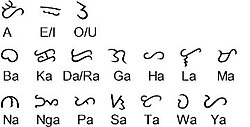User:Alternativity/Mobile Sandbox/History of the Philippines (900-1521)
Current
The known history of the Philippines is marked by the creation of the
This article covers the history of the Philippines from the creation of the Laguna Copperplate Inscription in 900 AD to the arrival of European explorer
From "Before 1521"
Thalassocracies and international trade (200AD - 1521)
The emergence of Barangay city-states and trade (200AD-500AD)

Since at least the 3rd century, the indigenous peoples were in contact with other Southeast Asian and East Asian nations.
Fragmented ethnic groups established numerous city-states formed by the assimilation of several small political units known as
Each barangay consisted of about 100 families. Some barangays were big, such as Zubu (Cebu), Butuan, Maktan (Mactan), Irong-Irong (Iloilo), Bigan (Vigan), and Selurong (Manila). Each of these big barangays had a population of more than 2,000.
In the earliest times, the items which were prized by the peoples included jars, which were a symbol of wealth throughout South Asia, and later metal, salt and tobacco. In exchange, the peoples would trade feathers, rhino horn, hornbill beaks, beeswax, birds nests, resin, rattan.2
In the period between the 7th century to the beginning of the 1400s, numerous prosperous centers of trade had emerged, including the Kingdom of
The growth of Literature and Hindu-Buddhist culture (900AD - 1380)

With the growth of a thalassocratic civilization, came the growth of literature. The
Society
By the 9th century, a highly developed society had already established several hierarchies with set professions: The Datu or ruling class, the Maharlika or noblemen, the Timawa or freemen, and the dependent class which is divided into two, the Aliping Namamahay (Slave) and Aliping Saguiguilid (Serfs).

The emergence of Baybayin script from Classical Kawi script (1200 onwards)
One example of pre-Spanish Philippine script on a burial jar, derived from
or Alibata.The growth of Islamic Sultanates (1380 - 1521)
In 1380,
Around 1405, the year that the war over succession ended in the
Scientific claims
Philippine history and anthropologists had only until very recently been limited to the rare artifacts that were discovered after the Spanish period, which had seen many artifacts from the pre-Hispanic era destroyed or reconverted. A good example of which is the Spanish walled city of
In February 1976, Fritjof Voss, a German scientist who studied the geology of the Philippines, questioned the validity of the theory of land bridges. He maintained that the Philippines was never part of mainland
Anthropologist F. Landa Jocano of the
Philippine historian
Notes
- ^ a b Laguna Copperplate Inscription - Article in English
- ^ The Laguna Copperplate Inscription. Accessed September 04, 2008.
- ^ "About Pasay -- History: Kingdom of Namayan" (HTML). pasay city government website. City Government of Pasay. Retrieved 2008-02-05.
^ Huerta, Felix, de (1865). Estado Geografico, Topografico, Estadistico, Historico-Religioso de la Santa y Apostolica Provincia de San Gregorio Magno. Binondo: Imprenta de M. Sanchez y Compañia.{{cite book}}: CS1 maint: multiple names: authors list (link)
^ "About Pasay -- History: Kingdom of Namayan" (HTML). pasay city government website. City Government of Pasay. Retrieved 2008-02-05. - ^ Remains of ancient barangays in many parts of Iloilo testify to the antiquity and richness of these pre-colonial settlements. Pre-hispanic burial grounds are found in many towns of Iloilo. These burial grounds contained antique porcelain burial jars and coffins made of hard wood, where the dead were put to rest with abundance of gold, crystal beads, Chinese potteries, and golden masks. These Philippine national treasures are sheltered in Museo de Iloilo and in the collections of many Ilonngo old families. Early Spanish colonizers took note of the ancient civilizations in Iloilo and their organized social structure ruled by nobilities. In the late 16th Century, Fray Gaspar de San Agustin in his chronicles about the ancient settlements in Panay says: “También fundó convento el Padre Fray Martin de Rada en Araut- que ahora se llama el convento de Dumangas- con la advocación de nuestro Padre San Agustín...Está fundado este pueblo casi a los fines del río de Halaur, que naciendo en unos altos montes en el centro de esta isla (Panay)...Es el pueblo muy hermoso, ameno y muy lleno de palmares de cocos. Antiguamente era el emporio y corte de la más lucida nobleza de toda aquella isla.” Gaspar de San Agustin, O.S.A., Conquistas de las Islas Filipinas (1565-1615), Manuel Merino, O.S.A., ed., Consejo Superior de Investigaciones Cientificas: Madrid 1975, pp. 374-375.
- ^ The Medieval Geography of Sanfotsi and Zabag[unreliable source?]
- ^ Scott 1984, p. 1.
- ^ Scott 1984, pp. 1 and Map 2 in Frontispiece.
References
- ISBN 971-10-0226-4, retrieved 2008-08-05.
- Zaide, Sonia M. (1999), The Philippines: A Unique Nation (Second ed.), All-Nations Publishing, ISBN 971-642-071-4.
Further reading
- Jocano, F. Landa (1975), Philippine Prehistory: An Anthropological Overview of the Beginnings of Filipino Society and Culture, Philippine Center for Advanced Studies, University of the Philippines System
- Regalado, Felix B; Franco, Quintin B. (1973), Grimo, Eliza B. (ed.), History of Panay, Central Philippine University
- ).
- ).
